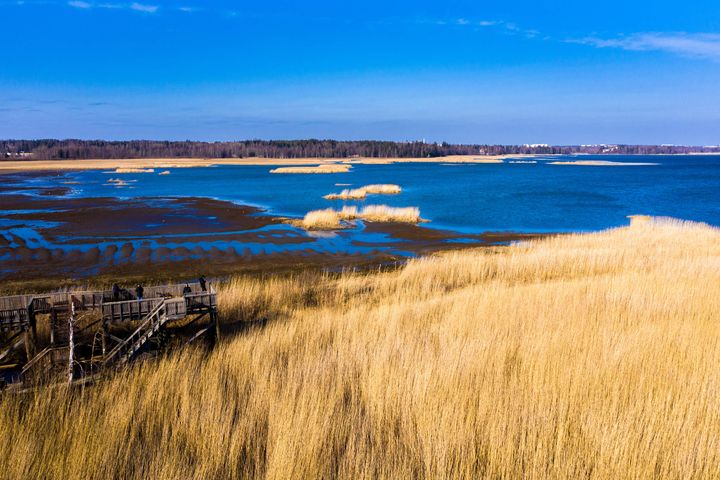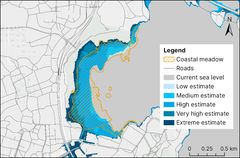Rising sea could erase a significant portion of coastal habitats in Finland
New study estimates that more than a fifth of coastal meadows and sandy beaches may disappear by the turn of the century.

Researchers at Aalto University and the Finnish Environment Institute have for the first time investigated how a rising sea level might impact coastal habitats in Finland. The results are a cause for concern: in the scenario considered most likely to occur, 22–23 percent of coastal meadows and sandy beaches would disappear beneath the waves by the year 2100. Failure to reach emissions reduction targets could cause the sea level to rise more rapidly, causing even greater habitat loss.
‘Coastal habitats are crucial for biodiversity. Their destruction would be an irreplaceable loss to the nearly 700 species that inhabit sandy beaches and coastal meadows,’ says Senior Researcher Terhi Ryttäri from the Finnish Environment Institute.
The new study focuses on the Gulf of Finland coastline, as it is where land uplift is the weakest and thus where sea levels will rise sooner. In the north, land uplift along the coast of the Gulf of Bothnia will slow the impact of sea level rise, yet the area remains susceptible to its effects.
Coastal meadows and sandy beaches do not shift easily
The researchers also investigated whether coastal habitats could shift to areas further inland as the sea rises. They found that this kind of movement is hindered by, among others, the built environment, steep hills, and unsuitable soil.
‘Buildings, roads, and other infrastructure often block habitats from expanding to new areas. Even if there is space for them in theory, not all areas can transform into sandy beaches or coastal meadows,’ says Elisa Kropsu, a geospatial specialist who has completed a master’s thesis on the subject at Aalto University.
The research revealed that, in terms of land area, the space for potential expansion outstrips the coastal meadows that will be lost to sea level rise – in theory. In practice, most of this land is being used for agriculture, and transformation into coastal meadows is not always possible. The expansion of sandy beaches is more limited due to a lack of suitable soil.
Habitats require protection, restoration, and long-term planning
The researchers stress that immediate action is required to protect the coastal environment.
‘Possible measures include the expansion of protected areas, improving the natural state of existing areas, and reserving and preparing suitable expansion areas for coastal habitats,’ says Maaria Nordman, assistant professor of geoinformatics at Aalto University.
The study was published recently in the Boreal Environment Research journal.
Keywords
Contacts
Elisa Kropsu
Geospatial Specialist
elisa.kropsu@ely-keskus.fi
p. 050 351 2967
Terhi Ryttäri
Senior Researcher, Finnish Environment Institute
firstname.surname@syke.fi
p. 0295 251 585
Media service at Finnish Environment Institute
Our Media Service provides information on research, helps journalists find experts for interviews and provides photos for media use.
Our Communication experts will answer your inquiries on weekdays from 9 am to 4 pm.
Images

Finnish Environment Institute - We build hope through research.
Finnish Environment Institute
Latokartanonkaari 11
00790 Helsinki
+358 295 251 000
It is time to move beyond solving environmental problems one by one, to systemic sustainability transformations. The Finnish Environment Institute (Syke) contributes to building a sustainable society through research, information and services. The Finnish Environment Institute is a research institute with 700 experts and researchers located in Helsinki, Oulu, Jyväskylä and Joensuu.

Subscribe to releases from Suomen ympäristökeskus
Subscribe to all the latest releases from Suomen ympäristökeskus by registering your e-mail address below. You can unsubscribe at any time.
Latest releases from Suomen ympäristökeskus
Höjningen av havsnivån kan förstöra en betydande del av de värdefulla naturtyperna vid den finska kusten12.6.2025 13:47:19 EEST | Pressmeddelande
Enligt en färsk undersökning kan över en femtedel av havsstrandängarna och sandstränderna försvinna före slutet av århundradet.
Merenpinnan nousu voi hävittää merkittävän osan Suomen rannikon arvokkaista luontotyypeistä12.6.2025 13:19:56 EEST | Tiedote
Tuoreen tutkimuksen mukaan yli viidennes merenrantaniityistä ja hiekkarannoista voi kadota vuosisadan loppuun mennessä.
Viikkokatsaus 16.–19.6.202512.6.2025 10:11:06 EEST | Tiedote
Hei! Tässä tiedoksesi meillä Suomen ympäristökeskuksessa ensi viikolla ilmestyviä tiedotteita, uutisia, kampanjoita, blogeja ja uutiskirjeitä. Mukana myös tulevia tapahtumia ja webinaareja. Jakelemme viikkokatsauksen torstaisin STT:n kautta. Koosteet löytyvät myös STT-uutishuoneesta, josta voit tilata kaikki Suomen ympäristökeskuksen tiedotteet.
Vuoden vesistökunnostaja -tunnustus Helsingin perhokalastajien Pekka Lindbladille12.6.2025 08:20:00 EEST | Tiedote
Valtakunnallisen vesistökunnostusverkoston Vuoden vesistökunnostaja -tunnustus myönnettiin 11.6. Helsingin perhokalastajat ry:n pitkäaikaiselle vapaaehtoisaktiivi Pekka Lindbladille. Lindbladin ja yhdistyksen pitkäjänteisen työn tuloksena Helsingin Mätäjoella elää luontaisesti lisääntyvä erittäin uhanalainen meritaimenkanta.
Maakuntien kasvihuonekaasutaseissa suuria alueellisia eroja11.6.2025 06:00:00 EEST | Uutinen
Suomen ympäristökeskuksen vetämä tutkimuskonsortio selvitti laajasti ilmastonmuutoksen, ihmistoiminnan ja maankäytön vaikutuksia kasvihuonekaasujen päästöihin ja hiilinieluihin alueellisesti ja valtakunnallisesti. Kasvihuonekaasupäästöjen ja -nielujen erotuksessa eli nettopäästöissä havaittiin suuria eroja eri maakuntien välillä.
In our pressroom you can read all our latest releases, find our press contacts, images, documents and other relevant information about us.
Visit our pressroom